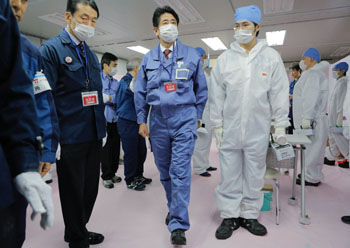Letter from JASON BARTASHIUS and ANDREAS NIDECKER

Readers offer some advice to the new prime minister on the contentious issue of nuclear power in post-3/11 Japan. The Japan Times, January 15, 2013. Letter from JASON BARTASHIUS and ANDREAS NIDECKER
Kyoto/Basel, Switzerland http://www.japantimes.co.jp/text/fl20130115hn.html
Take medical advice into account
Going nuclear again?: Prime Minister Shinzo Abe (center) inspects Tokyo Electric Power Co.’s emergency operation center at the crippled Fukushima No. 1 nuclear power plant in Okuma, Fukushima Prefecture, on Dec. 29. His ruling Liberal Democratic Party has pledged to review the previous Democratic Party of Japan government’s plans to phase out nuclear power. APDear Prime Minister Shinzo Abe,
In addition to the fear of thyroid cancer, for years to come many Fukushima parents will be plagued with the worry that their children may develop bone tumors or leukemia from exposure to strontium-90 (Sr90). A beta-radiating isotope difficult to detect with gamma cameras or Geiger counters, Sr90 is another invisible enemy possibly present in the environment due to the nuclear crisis at the No. 1 plant.
Like calcium, ingested Sr90 accumulates in bones. Also, it accumulates in teeth from fetal growth to the age of five. Dr. Martin Walter, a Swiss physician and member of the International Physicians for the Prevention of Nuclear War (IPPNW), is planning to measure the Sr90 levels in Fukushima children’s baby teeth.
Baby teeth collected this past year will be incinerated and dissolved in chemicals to ascertain how much Sr90 was in the environment before the nuclear disaster began. Teeth collected in the coming years will offer a means to judge how much Sr90 was emitted from the No. 1 plant when compared to the measurements of teeth collected in 2012. Martin intends to collect the baby teeth of Fukushima children for the next five to 10 years.
Sr90 is not found naturally in the environment. Nuclear weapons and power plants are its only sources. Baby teeth studies in the United States ultimately helped lead to the banning of atmospheric testing of nuclear weapons.
From 1945 to 1963 the U.S. tested 206 nuclear weapons in the atmosphere. In 1959, the Baby Tooth Survey was launched by the Greater St. Louis Citizens‘ Committee for Nuclear Information and the dentistry schools at Washington University in St. Louis and St. Louis University, with Dr. Louise Reiss as director. Over the course of 12 years nearly 320,000 baby teeth were collected. According to The New York Times, „The study ultimately found that children born in St. Louis in 1963 had 50 times as much strontium-90 in their teeth as children born in 1950 — before most of the atomic tests.“
The findings of Reiss‘ study came to the attention of President John F. Kennedy and were presented before a Senate committee in June 1963. Two months later, on Aug. 5, the U.S., Soviet Union and Britain signed the Partial Test Ban Treaty. Reiss had played a role in convincing world leaders to ban the testing of nuclear weapons in the atmosphere.
In recent decades similar tests have been conducted to determine how much Sr90 is being emitted into the atmosphere by nuclear power plants. Here in Japan, Yuko Nishiyama, a Fukushima mother and activist, is helping Walter collect the teeth. Nishiyama evacuated Fukushima city in March 2011. She first relocated temporarily in Tokyo and then chose to move to Kyoto with her daughter, where she started a support group for evacuees.
„I want people to know that this is something we’ll have to worry about,“ Nishiyama has said.
Prime Minister, we implore your administration to take into serious consideration the concerns of the international medical community when deciding the country’s future nuclear policy. Government officials must also bear in mind the anxieties of Fukushima parents when determining how they should be compensated and supported.
JASON BARTASHIUS and ANDREAS NIDECKER
Kyoto/Basel, Switzerland
Jason Bartashius is a lecturer and writer who lives in Kyoto. Professor Andreas Nidecker, M.D., is a radiologist and board member of the IPPNW. Send all your comments on this issue and Hotline to Nagata-cho submissions of 500-700 words to community@japantimes.co.jp.
Photo: Going nuclear again?: Prime Minister Shinzo Abe (center) inspects Tokyo Electric Power Co.’s emergency operation center at the crippled Fukushima No. 1 nuclear power plant in Okuma, Fukushima Prefecture, on Dec. 29. His ruling Liberal Democratic Party has pledged to review the previous Democratic Party of Japan government’s plans to phase out nuclear power. AP
